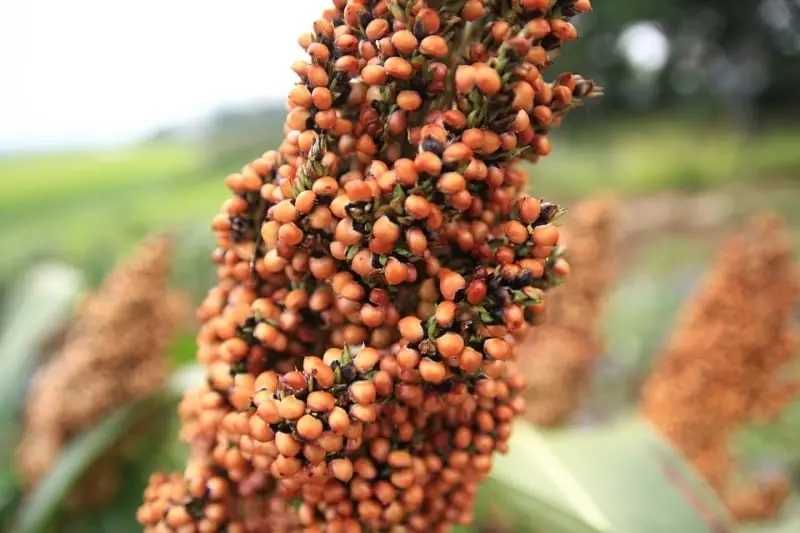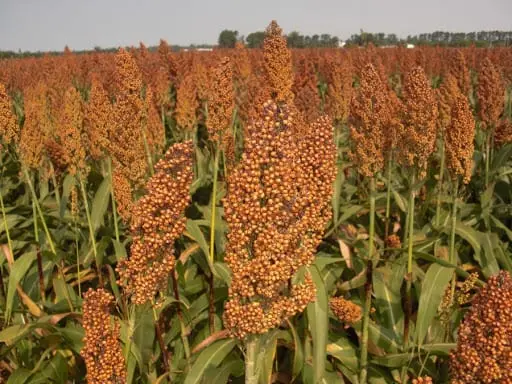Contents
Description
A grain such as Sorghum (Latin Sorghum, which means “to rise”), is popular as a natural raw material for making high-quality brooms due to its rather long and strong stem.
This annual plant’s homeland is East Africa, where this crop was grown in the 4th century BC. The plant spread widely in India, the European continent, Asia, and America.
Due to its resistance to dry and hot climates, sorghum has long been the most valuable food product and is still the main food source for the African continent’s peoples.
Today sorghum is one of the five most popular plants globally and has found application in a wide variety of areas of human activity. This culture grows well in the southern regions.
Sorghum history
Sorghum is famous as a grain crop since ancient times. According to Linnaeus and Vntra, in India, the birthplace of sorghum, they were cultivating it 3000 years BC.
However, no wild Kindred sorghum has been found in India. Therefore, the Swiss botanist A. Decandol is inclined to believe that sorghum originates from equatorial Africa, where the greatest variety of forms of this plant is now concentrated. Some American scientists adhere to the same point of view. Sorghum is known in China since 2000 BC. e.
Thus, there is no consensus on the origin of sorghum. One can only assume that this culture’s birth is equally associated with Africa, India, and China, where agriculture arose independently. The German literature also notes that sorghum is of polyphyletic origin with at least two origins – equatorial Africa and Abyssinia. India is also named as the third center.
Europe
Sorghum appeared in Europe much later. Nevertheless, the first mention of it contains the work of Pliny the Elder (23-79 AD) “Natural History,” where it is noted that sorghum was brought to Rome from India. This statement is highly speculative.
Most researchers determine the later date of sorghum penetration into the European continent – the 15th century when brought from India by the Genoese and Venetians. It was between the XV-XVI centuries. The study and distribution of the sorghum culture in Europe begin. In the XVII century. Sorghum was brought to America. As suggested by American and Soviet scientists, sorghum penetrated the local people captured in slavery from equatorial Africa.
World spread
Consequently, already in the XVII century. Sorghum was famous on all continents, but its main cultivation areas were still India, China, and equatorial Africa. There concentrated more than 95% of all world production of this crop. Interest in sorghum in Europe and America began to manifest itself only in the second half of the 19th century, at the time of its second import from China to France and America. According to A.G. Shapoval, in 1851, the French consul brought one sorghum seed from the island of Zung-Ming; it was sown in France and received 800 seeds. In 1853, these seeds penetrated America.
1851 English trader Leonard Vreidrie Hal to South America and became interested in the numerous sorghum varieties grown by the Zulus and Kaffirs. In 1854 he sowed 16 species of this culture he had brought with him in Italy, Spain, and France. These types of kaffir sorghum came to America in 1857 and initially spread in the states of Carolina and Georgia.
How sorghum grows
Sorghum is a rather unpretentious heat-loving cereal plant with a well-developed root system.

It is not difficult to grow this plant since it demonstrates good yields, is absolutely not demanding on the soil’s composition, and can grow even in marginal land conditions. The only negative is that it does not tolerate frost well.
But sorghum perfectly resists droughts, is resistant to many harmful insects and infections; therefore, in most cases, it does not require the use of expensive pesticides.
Composition and calorie content
- Proteins 11g
- Fat 4g
- Carbohydrates 60g
The calorie content of grain Sorghum is 323 kcal per 100 grams of product.
It contains the following useful elements: calcium; potassium; phosphorus; sodium; magnesium; copper; selenium; zinc; iron; manganese; molybdenum. Vitamins are also present in sorghum. The plant is enriched with the following vitamin groups: B1; AT 2; AT 6; FROM; PP H; folic acid.

Health benefits of sorghum
Sorghum can be white, yellowish, brown, and black. The benefits of porridge from such cereals are hard to overestimate. As already mentioned, sorghum is a storehouse of vitamins, and first of all – vitamins of group I.
Thiamine (B1) has a beneficial effect on the functions of the brain and higher nervous activity. It also normalizes gastric secretion, and heart muscle function increases appetite and increases muscle tone. Sorghum surpasses many other bowls of cereal in terms of riboflavin (B2) content. This vitamin supports skin and nails health and hair growth. Finally, pyridoxine (B6) stimulates metabolism.
Among other things, sorghum is an excellent antioxidant. The polyphenolic compounds included in its composition strengthen the immune system, protecting the body from the influence of negative environmental factors. They also resist the effects of alcohol and tobacco. Generally, scientists believe that blueberries are the leader in polyphenol content.
In fact, there are 5 mg of these nutrients per 100 g of blueberries and 62 mg per 100 g of sorghum! But grain sorghum has one, but very significant drawback – low (about 50 percent) digestibility. This is attributed precisely to the increased amount of condensed tannins (a group of phenolic compounds).

Sorghum protein, kafirin absorbs not really easily. For breeders in countries where sorghum is the main crop, increasing the digestibility of sorghum grain is a major challenge.
Harm and contraindications
Doctors do not recommend to use sorghum if you are hypersensitive to this product.
The use of sorghum
Grains of sorghum gained wide use as a raw material for food production: cereals, starch, and flour, from which cereals, tortillas. People also use it for baking bread, pre-mixing it with wheat flour for better viscosity.
The starch extracted from these plants is widely used in the pulp and paper industry, mining and textile industries, and medicine. In terms of starch content, sorghum surpasses even corn, making it much easier to grow it.
The sugar variety of sorghum contains up to 20% natural sugar (its maximum concentration is in the stems immediately after the flowering phase), so the plant is raw material to produce jams, molasses, beer, various sweets, and alcohol.
Cooking applications

Sorghum has a neutral, slightly sweetish flavor in some cases, so it can be a versatile product for a variety of culinary variations. This product is often a raw material for the production of starch, flour, cereals (couscous), baby food, and alcohol.
Lemongrass is popular because of its fresh citrus aroma in Caribbean and Asian cuisines for seafood, meat, fish, and vegetable seasonings. They combine cereal with garlic, hot pepper, ginger. Lemon sorghum is added to sauces, soups, drinks. Sugar sorghum makes delicious syrups, molasses, jam, and such drinks as beer, mead, kvass, and vodka.
Interestingly, this is the only plant whose juice contains about 20% sugar. From this grain crop, nutritious and tasty cereals, flat cakes, and confectionery products are obtained.
Sorghum in cosmetology
The extract, as well as sorghum juice, acts in cosmetics as a rejuvenating and firming agent. This ingredient is rich in complex peptides, polyepoxides, and sucrose. The content of polyphenolic compounds (especially anthocyanins) is 10 times higher than blueberries. It also contains amino acids, phenolcarboxylic acids, pentaoxiflavan and rare vitamins (PP, A, B1, B2, B5, B6, H, choline) and macroelements (phosphorus, magnesium, potassium, calcium, iron, copper, silicon).
To provide an immediate and at the same time prolonged lifting effect, sorghum juice forms a flexible, stretchable film on the skin surface. Besides, it normalizes micro and macro relief on the skin’s surface, leaving the skin taut, smooth, and radiant. It is also important that the effect of sorghum extract on the skin is long enough: complex peptides provide this effect in its composition.
Sorghum extract
Sorghum extract helps to achieve a sharper contour for a more radiant complexion. At the same time, this ingredient also provides a relaxing effect, which in combination gives a pronounced rejuvenating effect even with short use. It has also become known relatively recently that sorghum extract is capable of exhibiting anti-inflammatory activity.
The ground parts of sorghum are rich in proteins and other valuable bioactive components. Therefore, they are an additional source of ingredients for cosmetics, particularly for the production of individual peptides (hydrolysates). In a recent study, scientists treated them with proteolytic enzymes that break down proteins into peptides. It turned out that peptide hydrolysates were perfectly compatible with human skin fibroblasts and reduced enzymes that destroy collagen and elastin.
Sorghum porridge with black beans, amaranth and avocado
Ingredients
- Chopped cilantro (coriander) 70 g
- Black beans 450 tablespoons
- Canola oil 1 tablespoon
- Finely minced garlic 3 cloves
- Salt to taste
- Sorghum syrup 150 ml
- Avocado 1 piece
- Feta cheese to taste
- Onions 1 head

Cooking
- Transfer the washed beans to a bowl and add 200 ml. water for 4 hours, no more. Do not drain the water.
- In a large skillet, heat oil and place onion. Saute for 5 minutes, occasionally stirring, until tender, then add half the chopped garlic and cook for another 1 minute. Put the beans with water; the water should cover them by 3-4 cm; if less – add additional water and a boil.
- Reduce heat to low, remove any foam that appears, add coriander, cover and simmer for 1 hour.
- Add 2-3 teaspoons of salt to taste, leftover garlic, and coriander. Simmer for another 1 hour, until the beans are tender and the broth is thick and flavorful. Taste with salt and add as needed.
- While the beans are boiling, cook the sorghum. Rinse the cereals and stir in a saucepan with 3 cups of water. Add salt and bring to a boil. Reduce heat, cover, and simmer for 50 minutes, until grains are tender. Drain off the remaining water and return the cereal to the pot. Close the lid and set it aside for a while.
- When the beans are ready, mix them with the amaranth leaves and cook for another 10 minutes, until the greens are tender.
- Divide the sorghum into 6 serving bowls, toss with the beans, and amaranth. Serve with chopped avocado and coriander. If you don’t have enough space, add a little sauce or chopped green chili.
- Sprinkle with feta cheese on top and serve.









